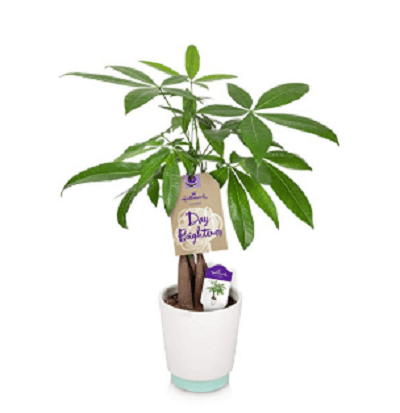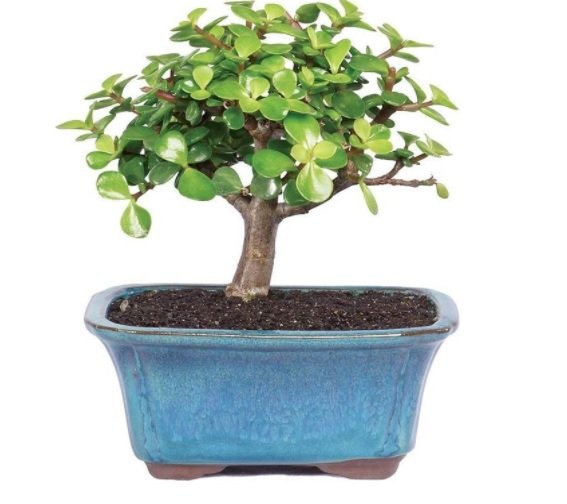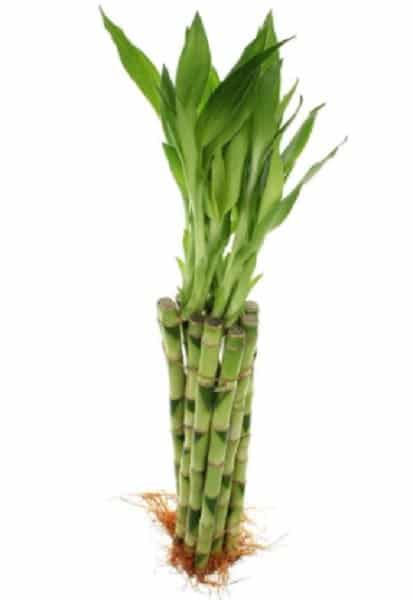Is Money Tree Different Than The Silver Version Plant
Which plant is the money plant?
There is a lot of confusion about which plant is the money plant. Is it a jade? Is it a golden pothos? Is it a Chinese money tree with a braided trunk? Is it pilea? Is it lunaria? The truth is, all of the named plants (and few more) are considered to be money plants. It's because there are quite a few types of money plants and we are going to learn all about them in this article, so you'll become a "money plants" expert!
What are "money plants"?
Money plants are plants that
- are believed to bring prosperity and good luck
- got their name because their leaves or seed pods resemble coins.
So, what people refer to as a "money plant" can be either 1), or 2), or a mixture of both.
Types of money plants:
1. Money Tree (Pachira aquatica)
also known as Malabar Chestnut, and Saba Nut

A Money Tree, as an ornamental house plant sold in stores, is actually made of multiple pachira plants with slender trunks woven together during their growth period, that is why it has a braided trunk.
Its bright green shiny leaves consist of 5 leaflets (fingers), though you can sometimes find a leaf with up to 9 fingers that is considered to be very lucky.
Though in their native wetlands of Central and South America Pachira Aquatica can grow up to 60 feet tall, as a houseplant it reaches up to 8 feet, which is still impressive for an indoor plant.
A Money Tree is not only believed to bring good financial fortune and prosperity to the owner, it also grows fast, is easy to care for, removes toxins from the air, and is not toxic for cats and dogs. So, there are plenty of reasons to get one for your home or office.
Why is Pachira aquatica a money plant?
5 leaflets on the stalk of the money tree represent well balanced energy of 5 elements of Feng Shui: wood, fire, earth, metal, and water. And when Qi is balanced and flows uninterrupted it restores harmony in our home and ensures good fortune and prosperity.
Money tree care
- a Money Tree needs bright light to grow, but keep it away from direct sun rays. It will grow well in artificial light
- rotate the Money tree at least once a week to prevent it from leaning into one direction
- a Money Tree will grow best in temperatures between 65°F to 85°F, it doesn't like cold
- keep a pachira plant away from drafts. If a money tree stands near the window, don't open the window in windy weather to prevent leaf loss Also, do not place a Money tree under the air register or near the radiator.
- Water once a week to keep soil moist. Do not overwater.
2. Jade Plant (Crassula ovata)
also known as Lucky plant, Money plant, Dollar plant, or Money tree.

The jade plant is a succulent houseplant with thick, glossy, jade-green oval leaves. Jade is known for its longevity – it can live 100 years or longer.
Jade plants can grow for many years without blooming, but a mature jade plant can blossom with white pink flowers at the end of winter – early spring if you reduce watering, stop fertilizing and will keep the room totally dark at night during winter time.
Jade plant is a perfect indoor air purifier. Just keep in mind that jade is mildly toxic to your pets.
Read related: 6 succulents that are toxic to cats
Why is jade a money plant?
Jade's numerous leaves resemble an abundance of coins, symbolizing money. That is why, according to Feng Shui, this plant attracts money, brings good luck, wealth, prosperity, and good fortune. It is an especially auspicious sign to the owner when a jade plant blooms.
Jade plant care
- jade plant thrives in bright light, but will not tolerate direct sunlight which might scorch leaves
- jade likes temperatures between 55 and 75 °F. Colder or warmer temperatures will cause leaf loss
- if you give a jade plant too much water, it will cause root rot. Too little water on the other hand, will make lower leaves shrivel and start to drop. It's better to water jade when the top inch of the soil in the pot dries out. Summer months, when the growth of new leaves occur, will require more frequent watering
- keep a jade plant away from drafts, air registers and radiators.
3. Pothos (Epipremnum aureum)
also known as money plant, devil's ivy. silver vine, Ceylon creeper, hunter's robe, ivy arum, Solomon Islands ivy, taro vine.

Pothos, a very prolific fast growing houseplant, can be trained to grow up as a climber or can gracefully drape down from the pot to soften up sharp furniture corners. It's very easy to care for and is almost indestructible. Keep in mind that the pothos plant is toxic for pets and humans if ingested.
There are plenty of varieties of pothos, and the leaves of each variety will have a different appearance. The most popular is a golden pothos known for its heart-shaped green with golden streaks leaves, neon pothos – with bright golden yellow leaves, marble queen pothos – which has green leaves with whitish streaks.
Why is pothos a money plant?
It's because Pothos leaves resemble coins (though leaves are heart-shaped. Go figure! 😊)
How to care for pothos
Pothos can tolerate a wide range of light conditions – it will grow in bright and low light, It doesn't like direct sunlight though. Soil can dry up between watering. If you often forget to water your houseplants, pothos is a perfect plant for you.
4.Lunaria
also known as Money plant, Silver Dollar plant, Honesty.

Want to bring some good money luck to your outdoor space? Then grow lunaria plant in pots on your patio or in flowerbeds.
Lunaria is a member of the mustard family. It grows up to 2 feet tall, is easy to care for, and produces clusters of pink or purple flowers on the top of the slender stem. It blooms from the beginning till mid summer.
Lunaria is a biennial plant – growing one year and flowering the next, and will die after producing seed pods. It reseeds easily if it has a dedicated space with undisturbed soil.
Don't forget to cut some of those fascinating seed pods on the stems though and bring indoors for dried flower arrangements.
Why is lunaria called a money plant?
Dried silvery round pods of lunaria resemble the look and size of silver dollars.
How to grow lunaria
Lunaria is very easy to grow and care for. Just scatter seeds directly on the soil at any time from spring till autumn. It can tolerate pretty much any soil or light condition and doesn't require much watering. The only thing lunaria doesn't like is soggy soil.
5. Pennywort (Hydrocotyle vulgaris)
also known ascommon pennywort, marsh pennywort, lucky plant, water navel, copper coin plant.

Pennywort is a low growing creeping perennial plant native to wetlands and marshes of Europe and Caucasus. It's edible and smells like carrots. It's shiny waxy bright green round serrated leaves are about 0.5 – 1.5 inch in diameter.
It can grow indoors and outdoors, in any light condition and can tolerate shade well. You can plant it also on the edge of your pond or in your water garden. If you keep pennywort indoors though, do not overwater.
Why is pennywort a money plant?
Pennywort's round leaves resemble copper penny coins in size.
6.Chinese money plant (Pilea peperomioides)
also known aspancake plant, UFO plant, lefse plant, missionary plant, "Bender Plant", mirror grass.

Chinese money plant is a great houseplant to decorate your indoor space, or give it as a gift for a friend, since Pilea is quite a trendy plant these days.
It grows fast, and is easy to care for.
A Chinese money plant likes well drained soil. It enjoys bright light, but not direct sunshine, and can take partial shade well. Pilea tolerates any temperature down to freezing. If you keep your room cool, it might encourage a Chinese money plant to produce tiny flowers.
Pilea forms baby plants – plantlets, that grow on stems under the soil. You can separate baby plants from the mother plant, set them in a glass with water to develop roots, and then transplant them into pots (or sell on Etsy 😊).
Why is Pilea a money plant?
The flat round leaves of Chinese Money plant resemble coins.
7. Lucky Bamboo (Dracaena sanderiana)

Lucky bamboo is probably the most popular Feng Shui plant in Western culture. It's not per se a money plant, it's a plant that symbolizes good luck, power, fortune, happiness, and prosperity (in which money plays a huge role, don't you agree ?😊) .
Do you know that lucky bamboo is not actually a bamboo? The plant is Dracaena Sanderiana, though the stalks of this plant do resemble bamboo.
How to grow Lucky Bamboo?
Lucky bamboo as a house plant will grow well in indirect light, in temperatures between 65 to 95°F. If you live in hardiness zones 10 and 11 (in the USA), you can grow your lucky bamboo outdoors.
You can grow your lucky bamboo in soil or in water. It will grow and live longer in the soil which should be kept damp.
If you are growing lucky bamboo in water, it's better to cover the roots with water and add pebbles or rocks around the bamboo stalks to hold them upright. Also use bottled spring water or filtered water for your lucky bamboo plants, it doesn't like chlorine or fluoride in water, and remember to change the water once a week.
Remember that a lucky bamboo plant is toxic for dogs and cats.
More on Lucky bamboo arrangement and symbolism
If you want to get creative, you can learn to shape lucky bamboo stalks to many shapes.
You can also arrange the bamboo stalks in meaningful combinations to represent what you desire in your life the most. According to feng-shui website
- 1 stalk of bamboo represents strong life filled with prosperity
- 2 – love
- 3 (most favorite combination) – happiness, long life and wealth
- 5 and 7 – good health
- 6 – prosperity
- 8 – growth,
- 9 – luck
- 10- completion
- 21 – blessing for great wealth and health.
Get inspired and get some ideas on how to decorate with Lucky bamboo from this YouTube video made by Organic Garden.
Is Money Tree Different Than The Silver Version Plant
Source: https://sowsmallgarden.com/types-of-money-plants/
Posted by: martineznevard.blogspot.com



0 Response to "Is Money Tree Different Than The Silver Version Plant"
Post a Comment